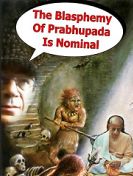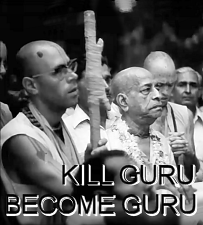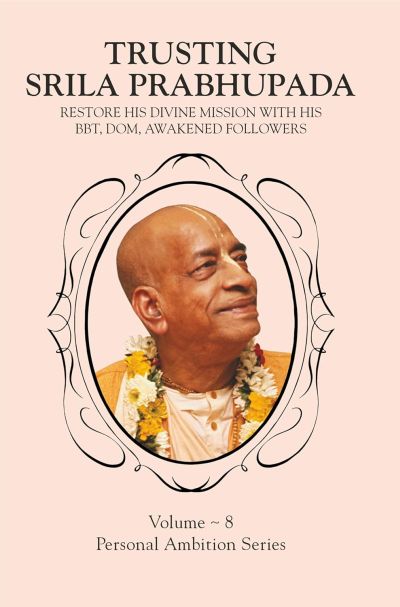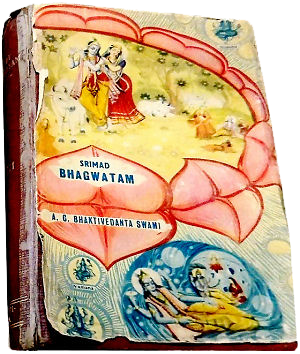BY: B. RADHA-GOVINDA
Srila Raghunath Das Goswami:
vairagya yug bhakti rasam prayatnair apayayan mam anabhipsum andha krpambudhih yah para duhkha duhkhi sanatanah tam prabhum asrayami
“Immersed in darkness, and unwilling to drink the nectar of devotional service possessed of renunciation, Sanatana Goswami, who is most compassionate to all the fallen souls, out of his causeless mercy, made me drink. Thus, I take shelter of my lord and master, Sri Sanatana Goswami.”
Srila Sanatana Goswami spent the last years of his life at Chakratirtha, writing and immersed in his bhajan. (He was sent by Sri Caitanya Mahaprabhu to Vrindavan to write books, and help discover the lost holy places.) At one point, due to the numerous mosquitos there, Sanatana Goswami decided to leave and do his writing and bhajan elsewhere.
Seeing that Sanatana Goswami was going to leave Chakratirtha, Lord Siva then came in the form of a brahmana, asked why Sanatan was going to leave, and upon receiving the explanation regarding how the mosquitos disturbance made it difficult for him to stay and continue with his writing and bhajan, the brahmana told him that there would no longer be any botheration to Sanatan from the mosquitos. From this time on, (including to this day), there were / are no more mosquitos.
It was at Chakratirtha that Sanatana Goswami departed the planet. Being most senior of the Six Goswamis of Vrindavan, and loved by all of the Vrajavasis, every year on Guru Purnima, the other Goswamis and so many Vrajavasis would come to offer Guru Puja to Sanatana Goswami.
When they came in 1588 to do so, seeing Sanatana Goswami making no movement, they realized that he had entered into samadhi, and with intense feelings of separation, brought his body to the Madan Mohan temple where his body was placed near the residence of his beloved Madan Mohan.
Madan Mohan was established by (Krishna’s great grandson), Vajranabha, but Madan Mohan, like other Deities of Krishna made by Vajranabha, disappeared from view for many years. It was Advaita Acarya Who found Madan Mohan under a banyan tree in Vrindavan at the bank of the Yamuna, where He performed bhajan and worshipped Madan Mohan there.
When departing Vrindavan, Advaita Acarya gave Madan Mohan to a grhastha brahmana, Damodar Caubhe, who lived in Mathura. At times, Sanatana Goswami would come to Damodar Caubhe’s house for madhukari, and would see the children of the family playing with the Deity of Madan Mohan. He saw that that Damodar’s wife would sit Madan Mohan at the table and give Him food with the other children. (The couple worshipped Madan Mohan in the vatsalya mood.)
Sanatana Goswami then explained the various rules and regulations for worshipping the Deity to Damodar’s wife, who found it very difficult to incorporate all that was being told to her, due to her mood of parental love for Madan Mohan.
Within time, on the same night, Madan Mohan came to both Sanatana Goswami and Damodar in a dream, Madan Mohana telling Sanatana Goswami that He was very happy being served and loved by the brahmana couple as one of their children and now that Sanatana Goswami had introduced so many rules and regulations, He was no longer feeling happy.
Madan Mohan explained to Damodar in dream that He wanted to now go with Sanatana Goswami, that since the brahmana had other children, he should give Madan Mohan to Sanatana Goswami.
Thus, the next day, both Damodar and Sanatan went to meet one another, Damodar agreeing to give Madan Mohan to Sanatan. Before accepting Madan Mohan, Sanatan got Him to agree to accept whatever simple offerings of foodstuffs Sanatan would be able to give, being that all that he received was through madhukari. On this agreement, Madan Mohan was accepted by His devotee, Sanatana Goswami, who made a simple hut for Madan Mohan to stay.
One day after offering to Madan Mohan only some dry chapatis (as this was what was obtained through madhukari that day), Madan Mohan asked if Sanatan could give Him a little salt. Sanatan replied that he was only able to offer to Madan Mohan that which he had received, and since he had received only some dry chapatis that day, Madan Mohan would have to be satisfied with that, so Madan Mohan accepted.
It was Sanatana Goswami’s desire to offer greater facility to His beloved Deity, so in Madan Mohan’s knowing this, He arranged for one wealthy merchant’s ship to become stuck on a sandbar in the Yamuna. It proved to be impossible to free the ship from its position, and the merchant prayed to Krishna to help him free his ship.
The merchant was directed to Sanatana Goswami, who after being told the merchant’s dilemma, Sanatana Goswami replied that there was nothing he could do to help the merchant, but told him to pray to Madan Mohan.
A great rain then came which released the boat from the sandbar, the merchant sailing the ship to Agra where his goods were sold at a huge profit. With this profit, under the direction of Sanatana Goswami, a beautiful temple was constructed for Madan Mohana, (also to be noted that the merchant became a disciple of Sanatana Goswami), but later, due to the atrocities of Aurenzeb, Madan Mohan was shifted to Jaipur.
Madan Mohan went to Karoli (where He is worshipped today), when the daughter of the king of Jaipur was offered in marriage to the king of Karoli. In her love for Madan Mohan, she asked that her father send Madan Mohana along with her to Karoli. The king did not want to allow Madan Mohan to leave Jaipur, but agreed that if his daughter, while blindfolded, would be able to pick Madan Mohan out from the other Deities after His being put in a room with other Deities, then Madan Mohan could go with her to Karoli.
Madan Mohan told the princess that she should not fear that she would not be able to pick Him out, His telling her that His arm would feel to her more soft than that of any of the other Deities. Thus, in this way, Krishna, as Madan Mohan fulfilled the desires of His devotees.
May we somehow be blessed by Srila Prabhupada, Srila Sanatana Goswami, and our Guru Varga on this day.
Your servant,
B. Radha-Govinda
Hare Krishna







Lovely transcendental story. Thank you very much.